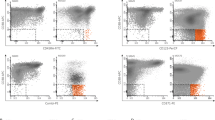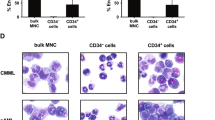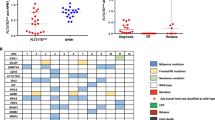Abstract
Acute myeloid leukemia (AML) is generally regarded as a stem cell disease. In CD34-positive AML, the leukemic stem cell has been recognized as CD38 negative. This CD34+CD38− population survives chemotherapy and is most probable the cause of minimal residual disease (MRD). The outgrowth of MRD causes relapse and MRD can therefore serve as a prognostic marker. The key role of leukemogenic CD34+CD38− cells led us to investigate whether they can be detected under MRD conditions. Various markers were identified to be aberrantly expressed on the CD34+CD38− population in AML and high-risk MDS samples at diagnosis, including C-type lectin-like molecule-1 and several lineage markers/marker-combinations. Fluorescent in situ hybridization analysis revealed that marker-positive cells were indeed of malignant origin. The markers were neither expressed on normal CD34+CD38− cells in steady-state bone marrow (BM) nor in BM after chemotherapy. We found that these markers were indeed expressed in part of the patients on malignant CD34+CD38− cells in complete remission, indicating the presence of malignant CD34+CD38− cells. Thus, by identifying residual malignant CD34+CD38− cells after chemotherapy, MRD detection at the stem cell level turned out to be possible. This might facilitate characterization of these chemotherapy-resistant leukemogenic cells, thereby being of help to identify new targets for therapy.
This is a preview of subscription content, access via your institution
Access options
Subscribe to this journal
Receive 12 print issues and online access
$259.00 per year
only $21.58 per issue
Buy this article
- Purchase on Springer Link
- Instant access to full article PDF
Prices may be subject to local taxes which are calculated during checkout




Similar content being viewed by others
References
Feller N, van der Pol MA, van Stijn A, Weijers GW, Westra AH, Evertse BW et al. MRD parameters using immunophenotypic detection methods are highly reliable in predicting survival in acute myeloid leukaemia. Leukemia 2004; 18: 1380–1390.
Venditti A, Buccisano F, Del Poeta G, Maurillo L, Tamburini A, Cox C et al. Level of minimal residual disease after consolidation therapy predicts outcome in acute myeloid leukemia. Blood 2000; 96: 3948–3952.
San Miguel JF, Vidriales MB, Lopez-Berges C, Diaz-Mediavilla J, Gutierrez N, Canizo C et al. Early immunophenotypical evaluation of minimal residual disease in acute myeloid leukemia identifies different patient risk groups and may contribute to postinduction treatment stratification. Blood 2001; 98: 1746–1751.
Kern W, Voskova D, Schoch C, Hiddemann W, Schnittger S, Haferlach T . Determination of relapse risk based on assessment of minimal residual disease during complete remission by multiparameter flow cytometry in unselected patients with acute myeloid leukemia. Blood 2004; 104: 3078–3085.
Bonnet D, Dick JE . Human acute myeloid leukemia is organized as a hierarchy that originates from a primitive hematopoietic cell. Nat Med 1997; 3: 730–737.
Costello R, Mallet F, Chambost H, Sainty D, Arnoulet C, Gastaut JA et al. The immunophenotype of minimally differentiated acute myeloid leukemia (AML-M0): reduced immunogenicity and high frequency of CD34+/CD38- leukemic progenitors. Leukemia 1999; 13: 1513–1518.
van Rhenen A, Feller N, Kelder A, Westra AH, Rombouts E, Zweegman S et al. High stem cell frequency in acute myeloid leukemia at diagnosis predicts high minimal residual disease and poor survival. Clin Cancer Res 2005; 11: 6520–6527.
Jordan CT, Guzman ML, Noble M . Cancer stem cells. N Engl J Med 2006; 355: 1253–1261.
Jordan CT, Upchurch D, Szilvassy SJ, Guzman ML, Howard DS, Pettigrew AL et al. The interleukin-3 receptor alpha chain is a unique marker for human acute myelogenous leukemia stem cells. Leukemia 2000; 14: 1777–1784.
Lowenberg B, Downing JR, Burnett A . Acute myeloid leukemia. N Engl J Med 1999; 341: 1051–1062.
Bakker AB, Van den Oudenrijn S, Bakker AQ, Feller N, van Meijer M, Bia JA et al. C-type lectin-like molecule-1: a novel myeloid cell surface marker associated with acute myeloid leukemia. Cancer Res 2004; 64: 8443–8450.
Lacombe F, Durrieu F, Briais A, Dumain P, Belloc F, Bascans E et al. Flow cytometry CD45 gating for immunophenotyping of acute myeloid leukemia. Leukemia 1997; 11: 1878–1886.
van der Pol MA, Feller N, Roseboom M, Moshaver B, Westra G, Broxterman HJ et al. Assessment of the normal or leukemic nature of CD34+ cells in acute myeloid leukemia with low percentages of CD34 cells. Haematologica 2003; 88: 983–993.
Cozzio A, Passegue E, Ayton PM, Karsunky H, Cleary ML, Weissman IL . Similar MLL-associated leukemias arising from self-renewing stem cells and short-lived myeloid progenitors. Genes Dev 2003; 17: 3029–3035.
Krivtsov AV, Twomey D, Feng Z, Stubbs MC, Wang Y, Faber J et al. Transformation from committed progenitor to leukaemia stem cell initiated by MLL-AF9. Nature 2006; 442: 818–822.
Wulf GG, Wang RY, Kuehnle I, Weidner D, Marini F, Brenner MK et al. A leukemic stem cell with intrinsic drug efflux capacity in acute myeloid leukemia. Blood 2001; 98: 1166–1173.
Terstappen LW, Loken MR . Myeloid cell differentiation in normal bone marrow and acute myeloid leukemia assessed by multi-dimensional flow cytometry. Anal Cell Pathol 1990; 2: 229–240.
van der Pol MA, Broxterman HJ, Pater JM, Feller N, van der MM, Weijers GW et al. Function of the ABC transporters, P-glycoprotein, multidrug resistance protein and breast cancer resistance protein, in minimal residual disease in acute myeloid leukemia. Haematologica 2003; 88: 134–147.
van Stijn A, Kok A, van Stalborch MA, van der Pol MA, Feller N, Westra AH et al. Minimal residual disease cells in AML patients have an apoptosis-sensitive protein profile. Leukemia 2004; 18: 875–877.
Hess CJ, Denkers F, Ossenkoppele GJ, Waisfisz Q, McElgunn CJ, Eldering E et al. Gene expression profiling of minimal residual disease in acute myeloid leukaemia by novel multiplex-PCR-based method. Leukemia 2004; 18: 1981–1988.
Acknowledgements
We acknowledge the Department of Cardiac Surgery and their patients for providing normal bone marrow samples.
Author information
Authors and Affiliations
Corresponding author
Rights and permissions
About this article
Cite this article
van Rhenen, A., Moshaver, B., Kelder, A. et al. Aberrant marker expression patterns on the CD34+CD38− stem cell compartment in acute myeloid leukemia allows to distinguish the malignant from the normal stem cell compartment both at diagnosis and in remission. Leukemia 21, 1700–1707 (2007). https://doi.org/10.1038/sj.leu.2404754
Received:
Accepted:
Published:
Issue Date:
DOI: https://doi.org/10.1038/sj.leu.2404754
Keywords
This article is cited by
-
Allogeneic TCRαβ deficient CAR T-cells targeting CD123 in acute myeloid leukemia
Nature Communications (2022)
-
The prognostic impact of Wilms tumor-1 polymorphism (rs16754) and human myeloid inhibitory C-type lectin-like receptor expression in cytogenetically normal-acute myeloid leukemia
Egyptian Journal of Medical Human Genetics (2021)
-
Towards precision medicine for AML
Nature Reviews Clinical Oncology (2021)
-
T-cell-based immunotherapy of acute myeloid leukemia: current concepts and future developments
Leukemia (2021)
-
An Update on the Clinical Evaluation of Antibody-Based Therapeutics in Acute Myeloid Leukemia
Current Hematologic Malignancy Reports (2021)



